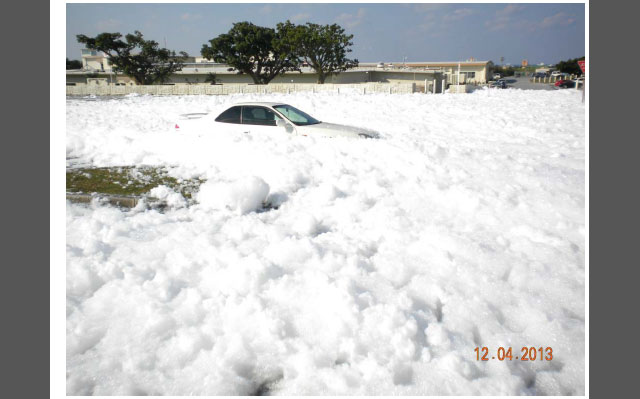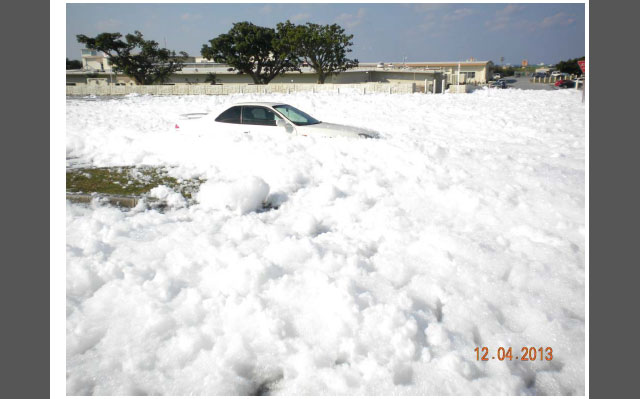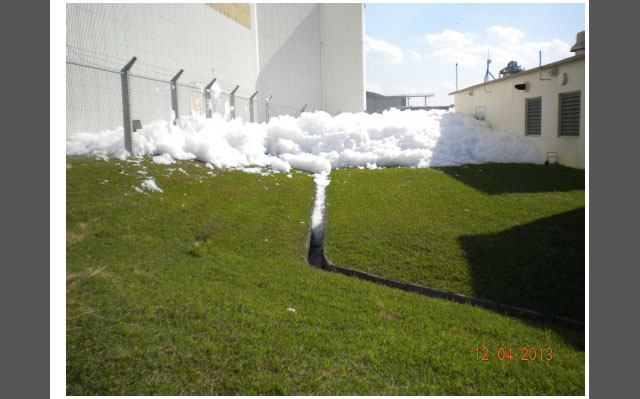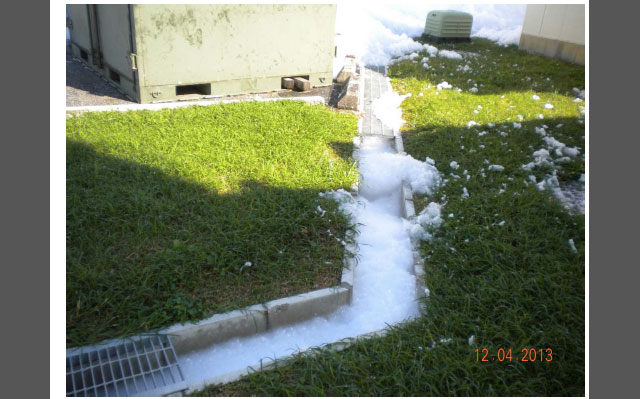
Documents released via MuckRock under the Freedom of Information Act (FOIA) reveal that lax safety standards at the largest USAF base in the Pacific may be to blame for recent contamination of drinking water sources on Okinawa.
The internal reports expose a spate of accidents at Kadena Air Base during the past 15 years which have leaked at least 21,000 liters of fire extinguishing agents — some of them toxic.
 On December 4, 2013, one accident – blamed on a switch and module malfunction – spread 2270 liters of fire extinguishing agents out of an open hangar and into storm drains on Kadena Air Base. (Photo: Jon Mitchell)
On December 4, 2013, one accident – blamed on a switch and module malfunction – spread 2270 liters of fire extinguishing agents out of an open hangar and into storm drains on Kadena Air Base. (Photo: Jon Mitchell)
 (Photo: Jon Mitchell)
(Photo: Jon Mitchell)
 (Photo: Jon Mitchell)
(Photo: Jon Mitchell)
In one incident last May, described by base officials as “vandalism”, a drunk Marine activated a fire-fighting system.[1] It filled a hangar with more than 1500 liters of JET-X 2.75% — a foam, classified by the U.S. government as hazardous, which contains chemicals known to cause cancer, neurological and reproductive disorders. Although the agent flowed off the base into nearby waterways and the ocean, military officials decided not to report the leak to Japanese authorities or local residents. Nor did they alert GIs or Okinawan employees on the base to the dangers.
In a statement to the military newspaper, Stars and Stripes, a USFJ spokesperson appeared more concerned about damage to aircraft than human health. “Kadena’s capabilities and readiness have not suffered,” quoted the newspaper.[2]
Other incidents at Kadena Air Base have included the escape of approximately 17,000 liters of agent during a three-day period in 2001, attributed by base officials to mechanical malfunctions.[3] Further leaks between 2012 and 2014 totaled more than 3400 liters. One was blamed on malfunctioning equipment; another on mechanical and electronic malfunctions. A third incident which spilled 1135 liters was recorded as “operator error.”[4]
The revelations appear to confirm Okinawan suspicions that the base has been polluting the local water system.
In January, Okinawa authorities announced that high levels of perfluorooctane sulfonate (PFOS) — an ingredient found in many fire extinguishing agents — had been discovered in waterways near the Kadena base. The area supplies drinking water to seven municipalities, including the prefectural capital, Naha.[5]
According to an announcement from the Okinawa Prefectural Enterprise Bureau on January 18, tests conducted between February 2014 and November 2015 recorded maximum PFOS levels of 80 nanograms per liter (ng/L) at its Chatan Purification Plant, rising to 1320 ng/L in Dakujaku River which is fed by water from the base. The bureau also noted that readings from a well within the installation had measured 1870 ng/L in 2008.[6]
The U.S. Environmental Protection Agency categorizes PFOS as an “emerging contaminant” that is readily absorbed by oral ingestion, accumulating in the blood, kidneys and liver. It does not break down easily in the environment or the human body where it has a half-life of up to 9 years.[7]
Due to concerns that PFOS can lead to reproductive and developmental problems, in 2009 the EPA set a provisional health advisory limit for drinking water at 200 ng/L for short term exposure. Although the Japanese government has not yet set any specific limits, it has fundamentally prohibited the production and usage of PFOS-containing products since 2010.[8]
The bureau noted that PFOS levels discovered near Kadena Air Base are far higher than on mainland Japan where, in the past ten years, they have only been recorded at a maximum of 22 ng/L.
On January 21, Okinawa prefecture asked the Okinawa Defense Bureau to seek permission from the U.S. military to access Kadena Air Base to check for sources of contamination.[9] Last year, Japan and the U.S. signed an environmental agreement which theoretically grants Japanese authorities the right to visit military installations in the case of chemical spills.[10] The Kadena contamination issue may serve as a test-case for the viability of the new agreement.
Three weeks after the request to access the base, USFJ had not yet responded to whether Okinawan officials would be granted access to the installation.
The FOIA documents highlight the shortcomings of Japan Environmental Governing Standards (JEGS), the guidelines regulating contamination on U.S. bases in Japan.[11] While JEGS require the U.S. military to notify the Japanese government immediately when “a significant spill… threatens the local Japanese drinking water resource”, the decision of whether to categorize a spill as “significant” or not is often left at the discretion of the U.S. military.
In the case of the drunk Marine’s dump of the carcinogenic agent last year, correspondence suggests that base officials at first mistakenly identified the chemical as “non-toxic”.[12]
By the following month they had recognized it as hazardous and they were aware it carried warnings that it should not be released into the environment. However, even though the agent had entered nearby waterways and the sea, because the names of its component ingredients were not listed in the JEGS table of hazardous chemicals, base staff decided there was no requirement to report the accident to the Japanese government.
Emails also show that base officials believed rainfall would dilute the agent and, because the incident occurred at night, it was “highly unlikely to draw any public notice because the foam would disipate (sic) before morning.”
According to the correspondence, there had been four previous spills of the same foam, some of which also went unreported.
When the news was initially reported on the front page of The Japan Times on February 9, media on Okinawa were quick to follow up. The story made the headlines of the Okinawa Times and topped the TV news. [13] However, Tokyo-based media failed to cover the story.
The way in which Kadena Air Base informed service members of the discovery of PFOS in the local water has also come under fire. On January 24, in a letter addressed to “Team Kadena”, base officials told those living on the base that, although PFOS had been discovered in local drinking water, “Be assured that your drinking water is safe.” [14]
Dr Masami Kawamura, director of Citizens’ Network for Biodiversity in Okinawa, accused the military of playing down the risks.[15] They failed to inform service members of the high levels found in nearby waterways, she says, and they appeared to mislead base residents by telling them that Okinawa Prefecture agreed that local water was safe to drink. Nor did they cite the air base itself as the source of contamination.
Komichi Ikeda, adviser at Environmental Research Institute Inc., Tokyo, agrees with Kawamura’s assessment of the risks.
“Although there are no regulations yet in Japan, there is growing evidence that these are high-risk chemicals. They are stable compounds that do not break down easily so they can accumulate in the body. They also bio-accumulate and they show signs of long-term toxicity.”
Kawamura urged base officials to inform USAF service personnel and their families of the potential risks to their health. She also likened Kadena’s response to their handling of the discovery of dioxin-tainted barrels near two base schools in 2013. In that case, too, the military appeared to put political priorities ahead of the health of American families.[16]
Manabu Sato, professor of political science at Okinawa International University, also called upon local and national officials to take action.
“Okinawa prefecture and municipalities near the base should conduct an independent investigation into the leaks. Moreover the Japanese government should require the U.S. military to notify it of any potentially harmful leakage — regardless of the amount. To decide the significance of a leak should not be left up to the U.S. military,” he said.
This is a revised and expanded version of an article which first appeared in The Japan Times on February 9, 2016.
In May 2015, Welsh journalist, Jon Mitchell, was awarded the Foreign Correspondents’ Club of Japan Freedom of the Press Award for Lifetime Achievement for his reporting about human rights issues – including military contamination – on Okinawa. He is the author of Tsuiseki: Okinawa no Karehazai (Chasing Agent Orange on Okinawa) (Koubunken 2014) and a visiting researcher at the International Peace Research Institute of Meiji Gakuin University, Tokyo. Mitchell is an Asia-Pacific Journal contributing editor.
Notes:
1. The entire 23 May 2015 report into the incident is available to read here.
2. “Drunk Marine releases fire suppression system in Kadena hangar,” Stars and Stripes, June 12, 2015. Available here.
3. The internal report from 2 July 2001 detailing the series of accidents is available here.
4. The 16 August 2012 report is here, the 4 December 2013 report is here and the 30 September 2014 report is here.
5. The discovery of PFOS contamination was widely reported in the Japanese-language media on Okinawa. An English translation of a report — “Chemicals detected in Kadena Air Base water,” Ryukyu Shimpo, January 19, 2016 — is available here.
6. The original announcement from Okinawa Prefectural Enterprise Bureau (in Japanese) is here.
7. The EPA’s fact sheet on emerging contaminants — including PFOS — is available here.
8. Japanese government regulations of PFOS are available via the Ministry of Economy, Trade and Industry — in Japanese — here.
9. “Detection of PFOS in drinking water leads to request for access onto US base compounds,” Ryukyu Shimpo, January 21, 2016. Available here.
10. Masaaki Kameda, “U.S.-Japan environmental agreement on U.S. bases flawed, experts say,” The Japan Times, September 29, 2015. Available here.
11. Department of Defense, “Japan Environmental Governing Standards,” December 2012. Available here.
12. The FOIA-released documents suggest that Kadena officials originally identified the leak as JET-X 2% — and the agent’s safety data sheet was included in the report together with the data sheet for JET-X 2.75%.
However, in follow-up correspondence, base officials stated that none of the three ingredients of the May 2015 foam is listed under JEGS. By crosschecking the two agents’ ingredients it can be seen that none of the ingredients of JET-X 2.75% is listed under JEGS, however JET-X 2% includes ethylene glycol — which is listed. Therefore it must be concluded that the foam released by the drunk Marine was JET-X 2.75%.
13. See, for example, QAB’s TV news report from February 10, here.
14. The letter can be read here.
15. A longer exploration of this issue can be read in Japanese here.
16. Jon Mitchell, “Kadena Moms Demand Truth”, The Japan Times, January 21, 2014. Available here.
Join us in defending the truth before it’s too late
The future of independent journalism is uncertain, and the consequences of losing it are too grave to ignore. To ensure Truthout remains safe, strong, and free, we need to raise $31,000 in the next 48 hours. Every dollar raised goes directly toward the costs of producing news you can trust.
Please give what you can — because by supporting us with a tax-deductible donation, you’re not just preserving a source of news, you’re helping to safeguard what’s left of our democracy.